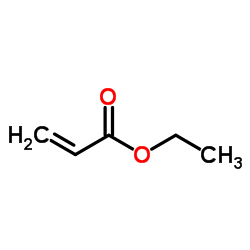丙烯酸乙酯
一般危化品

丙烯酸乙酯结构式
|
常用名 | 丙烯酸乙酯 | 英文名 | Ethyl acrylate TOP1 supplier |
|---|---|---|---|---|
| CAS号 | 140-88-5 | 分子量 | 100.116 | |
| 密度 | 0.9±0.1 g/cm3 | 沸点 | 99.5±0.0 °C at 760 mmHg | |
| 分子式 | C5H8O2 | 熔点 | −71 °C(lit.) | |
| MSDS | 中文版 美版 | 闪点 | 15.6±0.0 °C | |
| 符号 |


GHS02, GHS06 |
信号词 | Danger |
|
Preparation and application of sol-gel acrylate and methacrylate solid-phase microextraction fibres for gas chromatographic analysis of organoarsenic compounds.
Anal. Chim. Acta 837 , 52-63, (2014) Novel solid-phase microextraction (SPME) fibres containing methyl, ethyl, butyl acrylate and methacrylate were first prepared by a sol-gel technique and investigated for determination of selected organoarsenic compounds (lewisite, methyldichloroarsine, phenyl... |
|
|
Micro-computed tomography image-based evaluation of 3D anisotropy degree of polymer scaffolds.
Comput. Methods Biomech. Biomed. Engin. 18(4) , 446-55, (2014) Anisotropy is one of the most meaningful determinants of biomechanical behaviour. This study employs micro-computed tomography (μCT) and image techniques for analysing the anisotropy of regenerative medicine polymer scaffolds. For this purpose, three three-di... |
|
|
Controlled Assembly of Fibronectin Nanofibrils Triggered by Random Copolymer Chemistry.
ACS Appl. Mater. Interfaces 7 , 18125-35, (2015) Fibronectin fibrillogenesis is the physiological process by which cells elaborate a fibrous FN matrix. Poly(ethyl acrylate), PEA, has been described to induce a similar process upon simple adsorption of fibronectin (FN) from a protein solution-in the absence ... |
|
|
Neural tissue regeneration in experimental brain injury model with channeled scaffolds of acrylate copolymers.
Neurosci. Lett. 598 , 96-101, (2015) The objective of the present study was to evaluate the biocompatibility and cell hosting ability of a copolymer scaffold based on ethyl acrylate (EA) and hydroxyl ethyl acrylate (HEA) in vivo after an experimental brain injury. Wistar rats were subjected to c... |
|
|
Microfluidic conceived Trojan microcarriers for oral delivery of nanoparticles.
Int. J. Pharm. 493 , 7-15, (2015) In this study, we report on a novel method for the synthesis of poly(acrylamide) Trojan microparticles containing ketoprofen loaded poly(ethyl acrylate) or poly(methyl acrylate) nanoparticles. To develop these composite particles, a polymerizable nanoemulsion... |
|
|
Application of spherical silicate to prepare solid dispersion dosage forms with aqueous polymers.
Int. J. Pharm. 493 , 55-62, (2015) The objective of this study is to prepare and characterize solid dispersions of nifedipine (NP) using porous spherical silicate micro beads (MB) that were approximately 100 μm in diameter with vinylpyrrolidone/vinyl acetate copolymer (PVP/VA) and a Wurster-ty... |
|
|
Investigation of the interactions of enteric and hydrophilic polymers to enhance dissolution of griseofulvin following hot melt extrusion processing.
J. Pharm. Pharmacol. 67 , 918-38, (2015) This study focuses on the application of hot melt extrusion (HME) to produce solid dispersions containing griseofulvin (GF) and investigates the in-vitro dissolution performance of HME powders and resulting tablet compositions containing HME-processed dispers... |
|
|
Microfluidic conceived drug loaded Janus particles in side-by-side capillaries device.
Int. J. Pharm. 473(1-2) , 239-49, (2014) A side-by-side capillaries microfluidic device was developed to fabricate drug loaded poly(acrylamide)/poly(methyl acrylate) Janus particles in the range of 59-240 μm by UV-assisted free radical polymerization. This system was characterized in terms of contin... |
|
|
In vitro dissolution of proton-pump inhibitor products intended for paediatric and geriatric use in physiological bicarbonate buffer.
Int. J. Pharm. 485 , 152-9, (2015) Proton-pump inhibitor (PPI) products based on enteric coated multiparticulates are design to meet the needs of patients who cannot swallow tablets such as children and older adults. Enteric coated PPI preparations exhibit delays in in vivo absorption and onse... |
|
|
Enteric protection of naproxen in a fixed-dose combination product produced by hot-melt co-extrusion.
Int. J. Pharm. 491 , 243-9, (2015) In this study hot-melt co-extrusion is used as processing technique to manufacture a fixed-dose combination product providing enteric protection to naproxen incorporated in the core and immediate release to esomeprazole magnesium embedded in the coat. The pla... |